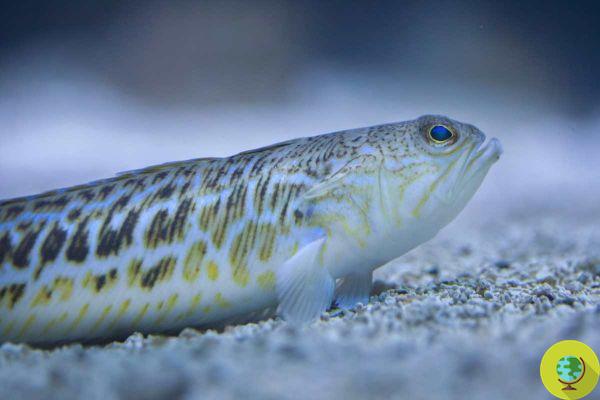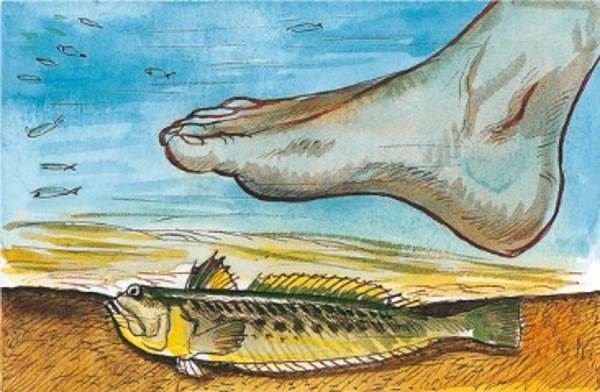Weever or spider fish are very common in the Mediterranean. It can happen that you are stung by the poisonous quills that are on the back
He is about to end up run over, his mother saves himWeevers or spider fish are very common in the Mediterranean, so it can happen that walking in shallow sandy bottoms or on the shoreline, you are stung by the poisonous quills that are on its back.
Index
Tracina: who he is and where he lives
Weepers belong to the Trachinidae family, which includes a small number of species found especially in European seas. These fish can be found in the Mediterranean, in the Black Sea, in European Atlantic waters, as far as Scotland in the north and the Canary Islands in the south, along the coasts of West Africa and in Chilean waters.
Weepers live exclusively in the sea and on sandy or muddy bottoms, preferably within the first 30 meters of depth, even if they have been reported at greater depths, up to 150 meters.
Tracina: how to recognize it
Weepers have a body flattened laterally, their body appears almost smooth, since they have small cyclioid scales. The eyes are lateral, high, and allow the animal to see when it is hidden in the sand.
It often happens to the less experienced to confuse the protruding eyes of the weeder for the siphons of the cannollicks (Ensis ensis) and therefore, when you put your hand in to pick them up you run the risk of being stung by the animal, which uses the poisonous thorns both for defense. and for offense, even against divers.
The dorsal spines are robust and poisonous; in resting conditions they are lowered, but are erected as soon as one approaches their hiding place or when they hunt prey. These spines are connected to a spongy tissue that produces venom.

@123rf/wrangel
Tracina: the puncture
If you get stung, the pain is immediate, but peaks after about twenty minutes. The sting comes from the backbone of the weever, which releases a poison, the tip will be red and swollen. Other symptoms may also occur such as nausea, vomiting and fever with a pain that can last several hours and also extends to the entire limb.
What to do if a weever stings you
A good remedy that you can use immediately if you are stung while on the beach is to put your foot in the warm sand. Avoid ice or cold water which make things worse (ammonia is not good either). If possible, immediately immerse the injured part in very hot water (37-max 40 ° C) because the temperature inactivates the protein toxins, which are thermolabile; if the heat treatment is done immediately after the puncture, the pain subsides quickly.
Painkillers, on the other hand, are not effective, they do not relieve the pain caused by the weever bite. Completely useless, even if original, are also remedies such as putting out a cigarette on the part where you have been stung, applying vinegar or urinating on the wound (any relief comes from the fact that the urine is hot).
On the other hand, it is useful to go to a doctor to assess the need for local or general care, based on the symptoms (symptoms) present, in particular the application of cortisone or antibiotic ointments on the wound and any anti-tetanus prophylaxis.
Rolando Tasinato, doctor at ULSS 3 Serenissima Hospital of Mirano (Venice) adds:
The pain in these cases is really very strong, intense and burning (painful sensation similar to that caused by contact with red-hot bodies) and is due to the inoculation under the skin of the toxic substance present in the quills, explains Tasinato. Here are his recommendations:
To prevent the pain and swelling caused by the sting of the spider fish and, in particular, by the venom of its spike, from creating further problems, it is necessary to:
- rinse with sea water and try to remove any fragments of thorns (if visible)
- thoroughly disinfect the affected area, possibly not with alcohol-based disinfectants but with Iodine Tincture, Amuchina or hydrogen peroxide.

Gallery
The remedies for the weever
To inactivate the poison it is also advisable to immerse the foot or the affected area as soon as possible in VERY HOT WATER (the highest possible temperature that allows us to keep the part immersed without incurring burns).
In fact, the spider fish toxin is thermolabile, that is, it is inactive and is destroyed at a temperature of about 45 degrees). Immersion in very hot water must continue at least half an hour until the pain subsides.
"In the hours following the puncture, some lines of fever may appear, especially in younger children, in other cases the persistence of pain, although attenuated by the foot bath with hot water, requires the intake of painkillers and in rare cases it is necessary to carry out an infiltration of anesthetic at the injection point ”, the doctor says.
In any case, pay attention ... where you put your feet! And remember that entering the water calmly, without running, gives the weeder time to move before the foot hits the sand, reducing the likelihood of being stung.
Sources of reference: Higher Institute of Health
Follow us on Telegram | Instagram | Facebook | TikTok | Youtube
Read also:
- Portuguese Caravel: If you meet this animal in the sea, don't touch it!
- Natural remedies for 25 small problems that can ruin your vacation


























